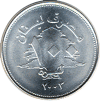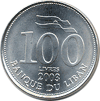Lebanese pound
| Lebanese pound | |
|---|---|
|
ليرة لبنانية (Arabic) livre libanaise (French) | |
| ISO 4217 | |
| Code | LBP |
| Denominations | |
| Subunit | |
| 1⁄100 | piastre |
| Symbol | ل.ل. |
| Banknotes | 1000, 5000, 10 000, 20 000, 50 000, 100 000 pounds |
| Coins | 250, 500 pounds |
| Demographics | |
| User(s) |
|
| Issuance | |
| Central bank | Banque du Liban |
| Website |
www |
| Valuation | |
| Inflation | 4.2% |
| Source | The World Factbook, 2007 est. |
| Pegged with |
US dollar US$ = 1507.5 LBP[1] |
The Lebanese pound (Arabic: ليرة lira; French: livre; sign: ل.ل., ISO 4217: LBP) is the currency of Lebanon. It was formerly divided into 100 piastres (or qirsh) but inflation has eliminated the subdivisions.
The plural form of lira, as used on the currency, is either lirat (ليرات) or the same, whilst there were four forms for qirsh: the dual qirshan (قرشان), the plural qirush (قروش) used with numbers 3–10, the accusative singular qirsha (قرشا) used with 11–99, or the genitive singular qirshi (قرش) used with multiples of 100. In both cases, the number determines which plural form is used. Before the Second World War, the Arabic spelling of the subdivision was غرش (girsh). All of Lebanon's coins and banknotes are bilingual in Arabic and French.
History
Before World War I, the Ottoman lira was used. In 1918, after the fall of the Ottoman Empire, the currency became the Egyptian pound. Upon gaining control of Syria and Lebanon, the French replaced the Egyptian pound with a new currency for Syria and Lebanon, the Syrian pound, which was linked to the French franc at a value of 1 pound = 20 francs. Lebanon issued its own coins from 1924 and banknotes from 1925. In 1939, the Lebanese currency was officially separated from that of Syria, though it was still linked to the French franc and remained interchangeable with Syrian money. In 1941, following France's defeat by Nazi Germany, the currency was linked instead to the British pound sterling at a rate of 8.83 Lebanese pounds = 1 pound sterling.[2] A link to the French franc was restored after the war but was abandoned in 1949.
Before the Lebanese Civil War, 1 U.S. dollar was worth 3 pounds. During the civil war the value decreased rapidly until 1992, when one dollar was worth over 2500 pounds. Subsequently the value increased again, and since December 1997 the rate of the pound has been fixed at 1507.5 pounds per US$.[3]
Coins
Lebanon's first coins were issued in 1924 in denominations of 2 and 5 girush (note the different spelling to post WWII coins) with the French denominations given in "piastres syriennes" (Syrian piastres). Later issues did not include the word "syriennes" and were in denominations of 1⁄2, 1, 2, 2 1⁄2, 5, 10, 25 and 50 girsha. During World War II, rather crude 1⁄2, 1 and 2 1⁄2 girsh coins were issued.
After the war, the Arabic spelling was changed from girsh (غرش) to qirsh (قرش). Coins were issued in the period 1952 to 1986 in denominations of 1, 2 1⁄2, 5, 10, 25 and 50 qirsh and 1 lira. No coins were issued between 1986 and 1994, when the current series of coins was introduced. Coins in current use are:[4]
| series | ||||
|---|---|---|---|---|
| Image | Value | Metal | Color | |
| 50 ل.ل. | Nickel | white | ||
 |
 |
100 ل.ل. | Copper - Zinc | red copper |
 |
 |
100 ل.ل.
(2003 Issue) |
Nickel | white |
 |
 |
250 ل.ل. | Bronze - Aluminum | golden yellow |
 |
 |
500 ل.ل. | Nickel - Steel | white |
Banknotes

Lebanon's first banknotes were issued by the Banque du Syrie et Grand-Liban (Bank of Syria and Greater Lebanon) in 1925. Denominations ran from 25 girsha through to 100 pounds. In 1939, the bank's name was changed to the Bank of Syria and Lebanon. The first 250-pound notes appeared that year. Between 1942 and 1950, the government issued "small change" paper money in denominations of 5, 10, 25 and 50 girsh or qirsh (the change in spelling occurred during these years). After 1945, the Bank of Syria and Lebanon continued to issue paper money for Lebanon but the notes were denominated specifically in "Lebanese pounds" (ليرة لبنانية, livre libanaise) to distinguish them from Syrian notes. Notes for 1, 5, 10, 25, 50 and 100 pounds were issued.
The Banque du Liban (Bank of Lebanon) was established by the Code of Money and Credit on 1 April 1964.[5] On 1 August 1963 decree No. 13.513 of the “Law of References: Banque Du Liban 23 Money and Credit” granted the Bank of Lebanon the sole right to issue notes in denominations of 1, 5, 10, 25, 50, 100, and 250 pounds, expressed in Arabic on the front, and French (livres) on the back. Higher denominations were issued in the 1980s and 1990s as inflation drastically reduced the currency's value. Banknotes in the current use are:
| Current series (2011) | |||
|---|---|---|---|
| Image | Value | Main Colour | |
| Obverse | Reverse | ||
| 1,000 ل.ل. | Green | ||
| 5,000 ل.ل. | Pink | ||
| 10,000 ل.ل. | Yellow | ||
| 20,000 ل.ل. | Red | ||
| 50,000 ل.ل. | Blue | ||
| 100,000 ل.ل. | Green | ||
All current notes feature an Arabic side with the value in Arabic script numerals of large size. The other side is in French with the serial number in both Arabic and Latin script and in bar code below the latter one.
See also
| Current LBP exchange rates | |
|---|---|
| From Google Finance: | AUD CAD CHF EUR GBP HKD JPY USD |
| From Yahoo! Finance: | AUD CAD CHF EUR GBP HKD JPY USD |
| From XE: | AUD CAD CHF EUR GBP HKD JPY USD |
| From OANDA: | AUD CAD CHF EUR GBP HKD JPY USD |
| From fxtop.com: | AUD CAD CHF EUR GBP HKD JPY USD |
References
- ↑ "About Banque du Liban | History of Banque du Liban". www.bdl.gov.lb. Retrieved 13 June 2016.
- ↑ "Payment Media, Banknotes and Coins - The Historical Development of the Lebanese Pound". Banque du Liban. Retrieved 2008-12-31.
- ↑ "Economic & Financial Data". Banque du Liban. Retrieved 2013-02-10.
- ↑ "Lebanese Currency Coins". Banque du Liban. Retrieved 2016-09-10.
- ↑ Linzmayer, Owen (2012). "Lebanon". The Banknote Book. San Francisco, CA: www.BanknoteNews.com.
- Krause, Chester L.; Clifford Mishler (1991). Standard Catalog of World Coins: 1801–1991 (18th ed.). Krause Publications. ISBN 0873411501.
- Pick, Albert (1994). Standard Catalog of World Paper Money: General Issues. Colin R. Bruce II and Neil Shafer (editors) (7th ed.). Krause Publications. ISBN 0-87341-207-9.
